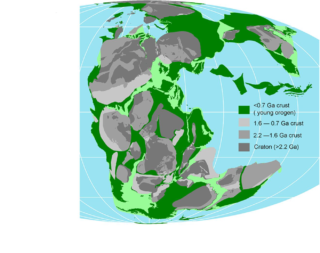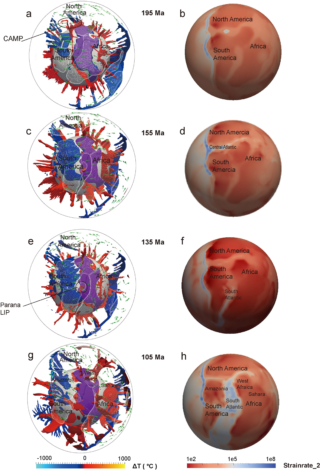Supercontinents break up along old scars
Ever wondered why the continents we have on Earth now are shaped the way they are? A recent publication in the new Nature journal Communications Earth and Environment has modelled the break-up of the latest supercontinent Pangaea leading to the opening of the central and southern Atlantic Ocean. This ground-breaking work, specifically taking into account its “old scars” or orogens in the supercontinent (Figure 1), was conducted by researchers from both Curtin University and Peking University. It shows that while the break-up of a supercontinent is triggered by mantle plumes, the locations for the development of continental rifts leading to the eventual break-up of the supercontinent, forming the continents as we see now, is largely guided by the orogens.

Plate tectonics assumes that the continents are all part of rigid plates, and that any deformation concentrates at the plate boundaries. Hence, geodynamic modelling regularly ignore the presence of in situ non-rigidity inside the tectonic plates. This simplification leads to large deviations of results from observations.
This work for the first time incorporated orogens into a global geodynamic model with realistic plate configuration of Pangea time in order to investigate the influence of orogen on the break-up of the supercontinent. In the model, the opening of Central Atlantic is driven by the plume responsible for the Central Atlantic Magmatic Province (CAMP) and occurred along the Pangea-forming young orogens. The rifting and eventual opening of the South Atlantic is controlled by necking between Pangea- and slightly older Gondwana-forming orogens, with the assistance of plume-induced lithospheric weakening (Figure 2). Without the CAMP-induced weakening, the rifting of the South Atlantic fails between the West African and Amazonian cratons, but instead occurs between the West African and Saharan cratons (see case 3, Figure 3).


This research emphasizes the importance of the global orogens, continental non-rigidity, and plume induced melt in determining the Earth’s geodynamic evolution. It is evident that the “old scars” likely had a major influence on the geometry of continental blocks and plate boundaries throughout most of Earth’s dynamic history. This model points to a way of more realistic modeling of Earth’s 3D dynamic evolution back to deep time.
Contact person: Prof Zheng-Xiang Li & Assoc Prof Nan Zhang, Earth Dynamics Research Group, Curtin University.
Relevant publications:
Dang, Z., Zhang, N., Li, Z.-X., Huang, C., Spencer, C.J., Liu, Y., 2020. Weak orogenic lithosphere guides the pattern of plume-triggered supercontinent break-up. Communications Earth & Environment, 1, 51. https://doi.org/10.1038/s43247-020-00052-z
